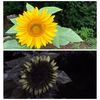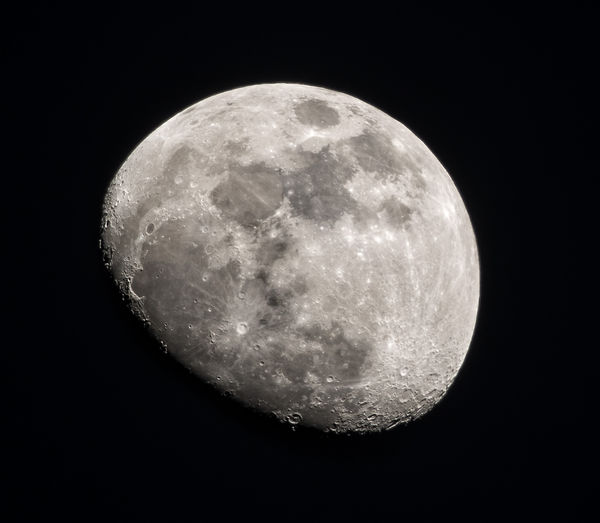Should I use a neutral density filter when taking a moon photo
Feb 27, 2016 08:39:13 #
OlinBost
Loc: Marietta, Ga.
I have tried to take photos of the moon but the reflection I encounter does not give me a sharp picture. Should I use a neutral density filter and which one?
Thanks, still so much to learn.
Thanks, still so much to learn.
Feb 27, 2016 08:51:00 #
I wouldn't use an ND filter.
You are using a tripod, correct? Zooms full out are subject to the slightest movement. You also have to meter on the moon. (or use manual settings starting at about 1/250 and f8 for a full and adjust from there.) Using averaging will throw the metering off (over expose the moon) since it includes the dark area around the moon.
You are using a tripod, correct? Zooms full out are subject to the slightest movement. You also have to meter on the moon. (or use manual settings starting at about 1/250 and f8 for a full and adjust from there.) Using averaging will throw the metering off (over expose the moon) since it includes the dark area around the moon.
Feb 27, 2016 08:52:07 #
OlinBost wrote:
I have tried to take photos of the moon but the reflection I encounter does not give me a sharp picture. Should I use a neutral density filter and which one?
Thanks, still so much to learn.
Thanks, still so much to learn.
You are probably over exposing your shot. A common mistake. Try using spot exposure to expose just for the moon's surface. Otherwise, as soon as you add the blackness surrounding the moon to the equation you end up over exposed. Shooting in "M" and using Live View allows you to fine tune your exposure also. An ND filter is not necessary and, by increasing exposure time, would probably result in a blurred photo. Remember, the moon is in constant motion so long exposures are undesirable.
Edit: BTW, as Longshadow mentioned, you are using a tripod, right? If you use Live View the mirror stays locked up, eliminating possible vibration. Use your timer or a remote shutter release. Turn off lens stabilization, unless the manufacturer recommends otherwise.
Feb 27, 2016 10:28:28 #
OlinBost wrote:
I have tried to take photos of the moon but the reflection I encounter does not give me a sharp picture. Should I use a neutral density filter and which one?
Thanks, still so much to learn.
Thanks, still so much to learn.
An ND filter would make it worse since you would need to increase the amount of time the shutter is open. Since the moon is moving you need to use a shutter speed of 1/125 sec or faster. Start with f/8, ISO 100, and live view with a remote release (on tripod of course). If too dark then open the f-stop up until you get the correct exposure.
Feb 27, 2016 11:33:30 #
OlinBost wrote:
Olin, I like your humility. I've got so much to learn, too. I've only seen the first 3 replies to your question; they all impress me as being logical and correct. My own response is I don't understand HOW reducing the amount of light by using an ND filter can improve what's already a light-starved subject.I have tried to take photos of the moon but the reflection I encounter does not give me a sharp picture. Should I use a neutral density filter and which one? Thanks, still so much to learn.
Tangential trivia time: How many f-stops brighter is the sun as compared to the moon when viewed from Earth?
.
.
.
.
.
.
.
.
.
19
Source: I read it in a photography book a few years ago.
Feb 27, 2016 11:49:52 #
OlinBost wrote:
I have tried to take photos of the moon but the reflection I encounter does not give me a sharp picture. Should I use a neutral density filter and which one?
Thanks, still so much to learn.
Thanks, still so much to learn.
I perceive no possible advantage to using an ND filter for any form of astronomical photography. Camera/lens vibration is one of the several banes of astronomical photography. Use of an ND filter would only lengthen exposure and thereby emphasize the problem of lens/camera vibration.
Dave in SD
Feb 27, 2016 13:07:33 #
LFingar wrote:
You are probably over exposing your shot. A common... (show quote)
Excellent advice!
It is especially important to remember that the moon is constantly moving because when we view it the motion is imperceptible to us, but our cameras will capture the slightest movement if we haven't used a fast enough shutter speed to compensate for that movement.
Feb 27, 2016 20:06:13 #
OlinBost wrote:
I have tried to take photos of the moon but the reflection I encounter does not give me a sharp picture. Should I use a neutral density filter and which one?
Thanks, still so much to learn.
Thanks, still so much to learn.
Generally speaking, the exposure you would use on a sunny day on earth would be the same you would use for shooting the moon, more or less.
F8, 1/250 ISO 100 is a good place to start. Your sharpest images will be when the moon is in partial phase, so that the light angle on the surface is lower providing nice contrast on the features.
Feb 28, 2016 01:51:30 #
OlinBost wrote:
I have tried to take photos of the moon but the reflection I encounter does not give me a sharp picture. Should I use a neutral density filter and which one?
Thanks, still so much to learn.
Thanks, still so much to learn.
You have already had some excellent replies. There are ways of improving any moon photo, and some just involve a better understanding of your subject and equipment. They don't really cost money so much as a little research, so they are not cheap tricks.
Good and successful moonshots involve 'expensive tricks'. Ask NASA. Investors refer to high risk startups as 'moonshots' and the ones that achieve a billion dollar value as 'unicorns'.
Getting a good shot of the moon other than by luck is an expensive trick in terms of understanding, planning, preparation and certain pieces of equipment. Notably the tripod.
I expect this thread will continue, but at least start from the understandong that good moonshots are hard to acheive.
Feb 28, 2016 02:19:04 #
Your settings should be for daylight, because that's what you are shooting.
I tend to expose to the right so, somewhere in the neighborhood of ISO100-1/250 to 1/320 @ f8 to f11 then, adjust accordingly :wink:
I tend to expose to the right so, somewhere in the neighborhood of ISO100-1/250 to 1/320 @ f8 to f11 then, adjust accordingly :wink:
Feb 28, 2016 02:20:56 #
Your settings should be for daylight, because that's what you are shooting. It may be dark here but, it's daytime on the moon.
I tend to expose to the right so, somewhere in the neighborhood of ISO100 SS1/250 to 1/320 @ f8 to f11 then, adjust accordingly :wink:
I tend to expose to the right so, somewhere in the neighborhood of ISO100 SS1/250 to 1/320 @ f8 to f11 then, adjust accordingly :wink:
Feb 28, 2016 07:00:14 #
Rule of thumb for starting exposure in daylight is the Sunny 16 rule - f/16 and shutter speed 1/ISO.
For photographs of the moon it's Loony 11 - f/11 and shutter speed 1/ISO.
For photographs of the moon it's Loony 11 - f/11 and shutter speed 1/ISO.
Feb 28, 2016 07:04:13 #
OlinBost wrote:
I have tried to take photos of the moon but the reflection I encounter does not give me a sharp picture. Should I use a neutral density filter and which one?
An ND filter will let you take longer exposures or use a larger aperture. The moon moves slowly but it does move so it is hard to see why you would want a longer exposure. A larger aperture would make focusing more critical and that seems exactly the opposite of what you would want. So no, a ND filter does not seem at all helpful.
One problem I had the first couple times I tried shooting the moon was with focus. I was focusing manually - something I would recommend for these shots, but I assumed that infinity would be at the extreme long setting and it turns out that is generally not the case. So that they do not accidentally prohibit focus at infinity, lens makers generally allow a little extra margin at the long-focus end.
Feb 28, 2016 08:27:52 #
photoman022
Loc: Manchester CT USA
A lot of good advice preceded me so I'll keep it short: No, you don't need a filter; use a tripod; shoot in manual, start at f/16 @ 1/125 and adjust your shutter speed from there (after all, you'll be on a tripod!); shooting a full moon is like shooting outdoors, in an open field, on a cloudless, sunny day, the sun knocks out the highlights. your best shots (with better contrast and details) will be when the moon waxes and wanes. I'm not as short as I thought I would be! Have fun shooting!
Feb 28, 2016 09:00:58 #
If you want to reply, then register here. Registration is free and your account is created instantly, so you can post right away.











